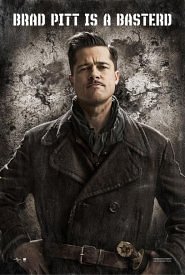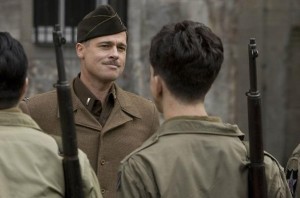 If you had any thought that Quentin Tarantino was going to deliver a conventional World War Two picture with Inglorious Basterds, then you really don’t know the director or his work at all. For a war film, Inglorious Basterds is short on action sequences and long on dialogue. That’s not to say that there is no action at all, though. What there is often serves as punctuation- short, machine-gun staccato bursts that cap a scene and relieve its rising tensions, demonstrating that if anything, Tarantino knows to heed Alfred Hitchcock’s observation “There is no terror in a bang, only in the anticipation of it.”
If you had any thought that Quentin Tarantino was going to deliver a conventional World War Two picture with Inglorious Basterds, then you really don’t know the director or his work at all. For a war film, Inglorious Basterds is short on action sequences and long on dialogue. That’s not to say that there is no action at all, though. What there is often serves as punctuation- short, machine-gun staccato bursts that cap a scene and relieve its rising tensions, demonstrating that if anything, Tarantino knows to heed Alfred Hitchcock’s observation “There is no terror in a bang, only in the anticipation of it.”
Lt. Aldo Raine (Brad Pitt) is in command of a special team of commandos. Dropped behind German lines, their mission is to cause as much havoc and mayhem to the Nazi troops as they can before the upcoming D-Day Invasion. Raine has given his small squad of soldiers an extra incentive- They each owe him 100 Nazi scalps. And he doesn’t mean that figuratively.
Meanwhile, Paris movie theater owner Shosanna Dreyfus (Melanie Laurent) has caught the eye of a young German soldier, Frederick Zoeller (Daniel Bruhl). Zoeller is something of a war hero to the Nazis, to the point where the story of his bravery has been turned into a film where he stars as himself. (Think the Nazi propaganda equivalent of Audie Murphy and 1955’s To Hell And Back.) In order to impress Shosanna, Zoeller uses his new found fame to convince Nazi propaganda minister Goebbels that the premier of the film should be at Shosanna’s theater. Unbeknown to Zoeller is the fact that that Shosanna has been hiding the fact that she is Jewish and sees the film premier as an opportunity to kill the entirety of the German High Command who will be at the event, with a plan that only a cinephile like Tarantino could conceive. However, when the Allies hear of the film premier and its gathering of high ranking Nazi officials, they order Raine’s squad in to assassinate who they can, oblivious to Shosanna’s own plans.
 But Tarantino films are never as much about the plot as they are about the characters and their dialogue. And Tarantino has crafted some amazing scenes here. The movie opens with a long scene in which Nazi officer Col. Hans Landa (Christoph Waltz, more on this guy in a moment), whom we will come to learn is nicknamed “The Jew Hunter,” is interviewing a French dairy farmer about the whereabouts of some neighboring Jewish farmers who have disappeared. Landa asks seemingly routine questions, interspersed with more benign ones, the farmer giving short, almost guarded answers. Is Landa just a bored functionary going through the motions of his work? But if so, why did he insist on conducting the interview with the farmer in English, not in either French or German?
But Tarantino films are never as much about the plot as they are about the characters and their dialogue. And Tarantino has crafted some amazing scenes here. The movie opens with a long scene in which Nazi officer Col. Hans Landa (Christoph Waltz, more on this guy in a moment), whom we will come to learn is nicknamed “The Jew Hunter,” is interviewing a French dairy farmer about the whereabouts of some neighboring Jewish farmers who have disappeared. Landa asks seemingly routine questions, interspersed with more benign ones, the farmer giving short, almost guarded answers. Is Landa just a bored functionary going through the motions of his work? But if so, why did he insist on conducting the interview with the farmer in English, not in either French or German?
This is but one scene in which Tarantino really flexes his muscles as a dialogue writer. Nearly every conversation serves to build tension in a scene. As Pitt and company move through Nazi-occupied France in disguise, they encounter eternally suspicious SS officers and spies who may or may not be on their side. Every conversation has hidden layers and no question is ever really innocent. But Tarantino also keeps the proceedings from becoming too paranoid, perhaps the tug of his oft avowed influence of exploitation cinema.
In addition to acting as regulators on the film’s suspense levels, the conversations often help to challenge the audience in its perceptions of whom the good guys and the bad guys are in war films. In an early scene, the Basterds have ambushed a German patrol, killing all but soldiers- a private and the commanding officer. Raine explains to the officer that they need information about other German patrols in the area. The officer refuses to divulge anything, as would an officer on any side of a conflict. But rather than take the officer prisoner, Raine has him beaten to death by the baseball bat wielding Basterd Sgt. Donny Donowitz (Eli Roth). Is the callous, cold-blooded, almost gleeful bludgeoning of a prisoner something we look for in our movie’s heroes? Tarantino doesn’t overtly comment on it, but leaves it to audience to discover and think about.
But while I am heaping praise on Tarantino’s scripting, I don’t want to neglect the film’s visuals. Tarantino stages many of his conversational moments quiet effectively, and one never gets weary just watching two or three people talk for long time at a stretch. Sure there are moments that look as if cribbed from other films; a shot in Basterd’s opening segment echoes an iconic shot from Ford’s The Searchers. Most directors do such things; it is only because Tarantino is often so vocal about his influences that we tend to make connections, whether intentional or not on Tarantino’s part, more quickly while watching his films. Additionally, the photography by cinematographer Robert Richardson manages to capture the warm earth tones of the French countryside as well as the stark, primary reds of Nazi iconography. His works especially helps sell the audaciousness of Tarantino’s finale, wherein the roles of Nazi tormentor and Jewish victim are literally reversed.
 Finally, a word or two about Austrian actor Christoph Waltz. Although he has some fame in Europe, Basterds marks the actor’s first American film, and what a debut it is. His Col. Landa is cold and calculating, but yet still carries with him a certain amount of charm. It is an incredibly difficult performance, yet he manages it flawlessly, making him perhaps the most engaging screen Nazi since Ralph Fiennes in Shindler’s List. And if that means there is an Academy Award nomination in his future, there is no complaint from me there.
Finally, a word or two about Austrian actor Christoph Waltz. Although he has some fame in Europe, Basterds marks the actor’s first American film, and what a debut it is. His Col. Landa is cold and calculating, but yet still carries with him a certain amount of charm. It is an incredibly difficult performance, yet he manages it flawlessly, making him perhaps the most engaging screen Nazi since Ralph Fiennes in Shindler’s List. And if that means there is an Academy Award nomination in his future, there is no complaint from me there.



